The history of the Antei Combat Center is intimately tied with the history of single combat within the Dark Jedi Brotherhood. The Brotherhood’s past, present and future are shaped by wars, politics and rites of power, but these processes are merely unanswered questions, sanguinary superpositions, until they are collapsed by the final, decisive duel. This is where the Combat Center exists, in the dire clash of wills, of cardinal powers, that ultimately resolves every dilemma. Darth Sarin and Omancor Crask on Antei, Halcyon Taldrya and Michael Halcyon on New Tython, Aidan Kincaid and Timeros on Begeren, Muz Ashen and Jac Cotelin on Korriban, Darth Pravus and Solari on New Tython. The Center has validated itself every time the heroes and enemies of the Brotherhood have crossed sabers, because it is the Brotherhood’s aspect of conflict and rivalry between two adversaries, manifested through the arts of combat and the will to victory.
This might be the heart of the Combat Center, but the society also defines itself by its adaptability, its endurance through great turmoil and its power to reflect the changing forms and tempers of the Brotherhood. The Combat Masters have led the Center through golden ages, eras of atrophy and decay, collapse and resurgence, strife and stability. In the end the Center has always come out strong and bold. As long as there is conflict within the Brotherhood there will be a Center, for what is the Brotherhood without conflict?
Acta Est Fabula
ca. 12 ABY to 30 ABY
For a detailed history before 30 ABY, see History of the Antei Combat Center pre-30 ABY
- "You long for your recognition, your glory. You want the universe to know your power, to be counted as the one and not of the many. To rise above all other names, to be the pinnacle, to be the one left standing... that is your desire, your quest."
- ―CM Dalthid, 16 ABY
 Dalthid, legendary Champion and Combat Master
Dalthid, legendary Champion and Combat Master
The art of the duel in the Brotherhood has its roots in the Ritual of Certamen of the Triumvirate era. The ancient Star Chamber instituted this ritual combat to the death as a route for their subjects to settle disputes. About three thousand years later, the Brotherhood’s Krath Order rediscovered this Rite and remodelled it to their own necessities. In the ritualized non-lethal duels of the Krath Combat Center, the Order of the Scholars recognized that combat imparted as much knowledge about one’s self, one’s opponent and the universe we operate in as any ancient holocron.
The Rite was soon expanded to all three Orders, but it was not until after the Exodus that the Antei Combat Center acquired its current name. Under a succession of enterprising Combat Masters the Center developed state-of-the-art facilities, both on Antei and on the Abyss space station, and established itself as the nucleus for lightsaber combat training in the Brotherhood. The ACC did not just instruct initiates in the lightsaber Forms. It also drew the Brotherhood’s masters of the martial arts. Timeros, Dalthid, Muz Ashen, Halcyon Rokir. All these legendary champions, and more, left their mark on the martial milieu of the Center, and in turn the Center passed on this experience to the new generation of Dark Jedi warriors.
However, at its heart the Combat Center was born of ritual and convention. As the Brotherhood experienced several violent wars and conflicts, the Center struggled to remain relevant and innovative. The Invasion of New Tython, the Horizons crisis and the opening salvos of the Dark Crusade drew combatants away from the rigid, formulaic praxis of the ACC. Masters and veterans of warfare chose the bloody battlefield over the lifeless Combat Halls every time, and new recruits no longer saw the value of the ritualized katas and stifling training regimens when they could wet their blades in the blood of real enemies.
Activity within the ACC facilities declined until, in 30 ABY, Grand Master Muz finally withdrew Dark Council funding and the Center was shut down. Pravus, Voice of the Brotherhood at the time, redirected remaining resources towards a comprehensive restructuring of the Center. He charged the new Combat Master Shadow Taldrya, and subsequently his successor Telaris Taldrya Cantor, with recasting the ACC to suit the modern martial needs of the Brotherhood. Pravus was also keen that the future ACC should mesh with his vision for the parent office of the Voice. In the Center’s network of instructors, trainers and operatives he saw an opportunity to surveil the warriors of the Clans and Houses, to track their martial aptitude and their individual quarrels and rivalries for his own advantage. From now on, Pravus would keep a personal watch on the Combat Masters and their work, to ensure the Center’s reconstruction proceeded towards this more covert purpose.
The Center on Trial
31 ABY
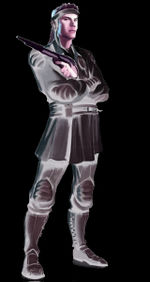 CM Telaris
CM Telaris
- "Why? I surrendered... I didn’t want this! Why did it have to be like this?"
"It's nothing personal. You're just a means to an end."
- ―Aidan Kincaid and his opponent on Krayiss II
Within a few months, it was clear that the renovation of the ACC would need to be far more drastic and wide-ranging than initially expected. The project became a significant drain on the Dark Council’s resources, especially in a time of war, and pressure began building, from both upper and lower echelons, for tangible results to be put forward. To placate these detractors, during the closing stages of the Dark Crusade Combat Master Telaris orchestrated a series of duelling trials[1] on a number of the captured Sith Worlds.
The ACC’s advances so far were not counted in new facilities or halls of combat. The Combat Masters saw the reality of modern duels in the Brotherhood, that they occurred far from Antei, Abyss and even Brotherhood space, and they developed the Center’s new networks, systems and technologies accordingly. Telaris’ duelling trials put these developments through their paces as the ACC monitored, overtly and covertly, the various encounters taking place on the Sith Worlds.
Master Aidan Kincaid emerged as the victor of the trials. The data extracted by the Center both validated the project’s progress and provided a roadmap for the future. The prestige of victory and the humiliation of one’s rivals was sufficient motivation for the combatants to put their skills on display, their fighting styles, their intention and determination, their weak spots and triggers. The information gathered also streamed outside of the Center, where a team of lightsaber masters employed by the Dark Council were studying and reviewing the lightsaber Forms favored by the modern Brotherhood.
The Game Has Begun
32 ABY
- "We are Dark Jedi. We choose our paths and do not stray. What other choice is there?"
- ―Timeros
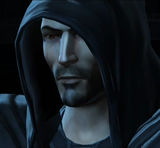 Aidan Kincaid, Champion
Aidan Kincaid, Champion
The success of the duelling trials was a prelude to the ACC’s formal relaunching. Even as the campaigns of the Dark Crusade came to a close the Center on Antei reopened its doors. Once again the training halls were filled with the hum of lightsabers, with initiates sent by the Shadow Academy eager to prove their worth and veterans surging like torrents through their favoured Forms.
At this time the Brotherhood’s attention was still fixed on the threat of the One Sith. Darth Ashen’s gaze turned to Begeren, where he sent warriors from the Clans and Houses to secure powerful artifacts and military installations[2]. This is where the reborn ACC made its first mark upon the conflict. The Grand Master and the Voice needed two expert fighters to confront a linchpin of the One Sith, whom they knew to be holed up on Begeren. CM Telaris tracked and monitored the fights that broke out amongst the brethren and against the One Sith. He used the information to select Aidan Kincaid and Timeros Caesus Entar Arconae as the two most capable candidates for this mission.
In an ancient palace on Begeren, Kincaid and Timeros encountered Darth Necren. Their fight with the assassin uncovered that she was serving a treasonous Dark Councillor, but the two Elders were captured before they could discover the name of the traitor. The slaying of Darth Necren, the capture of the Elders and the revelation of Dark Council treachery only went to show how deeply a mere duel can shape the progress of a war and the security of the entire Brotherhood.
Civil War
32 ABY
- "And they were enemies: they met beside
The dying embers of an altar-place
Where had been heaped a mass of holy things"
- ―The Final Way[src]
The death-toll imposed by the One Sith menace and the stench of treachery present at the highest levels of Brotherhood hierarchy heralded a period of political instability within the Dark Council. Pravus, ever conscious of the special role the Combat Center had been playing in his bid for power, maintained an aegis of support over Telaris. When Pravus became Shadow Hand, Telaris stepped into the office the Sith Lord had just vacated.
As the new Voice, Telaris became acutely alert to the schisms forming within the Brotherhood at this time. Instead of selecting a new Combat Master he provisionally assimilated the position into his own direct sphere of authority. When Jac Cotelin and the Taldryanite fleet besieged Antei, the Voice was in a position to employ the Antei Combat Center’s military assets in his Clanmate’s favor. The coup’s gambit ultimately failed, and the Center’s planetary facilities were all destroyed when Darth Ashen performed his first Rite of Immortality.
This event signalled another temporary disintegration of the ACC structure. Telaris joined Grand Master Jac in his campaign against Darth Ashen, but the rest of the Center’s instructors and operatives became split largely along the lines of Clan or House loyalty. Some sided with Jac, others remained faithful to the ruling Grand Master and a few went with Plagueis and Esoteric.
The Gray Fang
32 ABY
- "The crystal, the blade, the warrior: all are intertwined. All are one."
- ―Ferran, Triumvir of the ancient Star Chamber
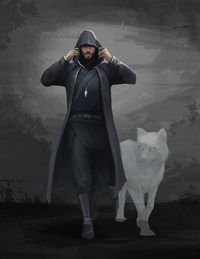 CM Marick
CM Marick
The Antei Combat Center survived the Civil War, though not unchanged. When Darth Pravus took the Iron Throne, it was no surprise that he selected Telaris to be his Shadow Hand. In the joint office of Voice and Combat Master the two Sith Lords placed Aidan Kincaid, a Taldryanite Master who had distinguished himself several times in the arenas of the ACC. The Center’s rapid recovery after the Civil War demonstrated that it was no longer reliant on physical structures for its operations, but rather on the expertise and ceaseless activity of its trainers and operatives, and its strong links with the office of the Voice and the Shadow Academy. As long as there were instructors brimming with knowledge and initiates willing to learn, masters seeking perfection and Forms defying comprehension, then the ACC would find its place and thrive.
Though Kincaid’s tenure was relatively short, he oversaw two developments of importance to the Center. The first was the publishing of the research completed by the Dark Council’s lightsaber masters[3]. This authoritative compilation of the lightsaber Forms reflected the styles of lightsaber combat favored in the modern Brotherhood. It informed the initiate training programmes developed jointly by the Center and the Shadow Academy and it was an essential tool for the cataloguing of lightsaber practitioners across the Brotherhood. The more the Center understood the ways Brotherhood warriors engaged in combat, the more the Combat Master and, ultimately, the Grand Master gained ways to control them.
The second development was the selection of then Marick Arconae as Combat Master. Though the head of the ACC once again became independent, the tradition of close relations between the Voice and the Combat Master never ceased. This was a necessity dictated, in great part, by the increasing importance of the Center’s information gathering role. Marick’s focus on revamping the training protocols and resources available to members of the Brotherhood went hand in hand with his work as a Grand Inquisitor, creating the legacy that would lead him to being known as “The Gray Fang.” The appointment also brought some much needed composure to the Center. Marick’s tenure ushered a period of stability and steady growth for the ACC.
Blood Will Beget Blood
32 to 33 ABY
- "Typical Jedi. Your arrogance will be your downfall."
- ―Andrelious, Combat Master's Champion
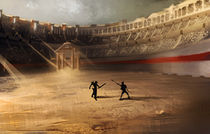 The ancient arena discovered on Arx’s moon
The ancient arena discovered on Arx’s moon
The new Combat Master acted quickly to reinforce the ACC’s presence in the Brotherhood, and if there was any suspicion that the Civil War had shaken the Center’s footing, those rumors were soon put to rest. In his first resolution, he filled the Center’s circle of instructors with operatives from across the Clans. This ensured that the ACC had collaborators seeded throughout the Brotherhood. They acted as the Combat Master’s eyes, ears and mouthpiece in their respective Clans, as they kept him abreast of the fighting capabilities of their clanmates and transmitted his combat training reforms to their units.
Marick also worked to secure a place for the ACC in the Brotherhood’s future. When he was made Combat Master, Marick was taken to the dark place where, unbeknownst to the rest of the Brotherhood, the Grand Master was building his new imperial capital. On one of the planet’s orbiting moons he discovered the ruins of a colossal arena left by the ancient civilization of that planet. The Combat Master assigned labor and resources to rebuilding the arena and developing training halls in its vicinity. This investment would eventually become the public front of the ACC, and a symbol of its physical presence at the heart of the Brotherhood.
In 33 ABY the Combat Master announced the third major undertaking of his tenure. With the collaboration of the Dark Council and the Clan Summits, Marick arranged a series of combat skirmishes[4] on various disparate worlds. Following the precedent set by previous contests, the ACC covertly monitored the duels as they unfolded, collating the data for the benefit of the interested parties. For the Clans, this was an unmissable opportunity to test the spirit of their own fighters and vye for the champion’s title, which ultimately was taken by Warlord Andrelious J. Mimosa-Inahj. For the Center, the duels provided invaluable information on the rivalries and antipathies that existed between Brotherhood members. These warriors went into battle with sabers, blasters and combat talents, but also grudges, feuds, loyalties, ambitions, convictions, impulses. It was the Center that gathered all these threads to the Grand Master’s hand, for him to pull at his will.
Mercy Exists for No One
33 ABY
Within the ACC, Marick’s combat skirmishes were catalyst to changes that were already convulsing the rest of the Brotherhood. In the eyes of the Combat Master each duel was a microcosm of the fears, hopes and tribulations of each Clan. Through this viewport he saw how the Krath and Obelisk Orders were increasingly shunned, how Iron Throne loyalists were becoming less tolerant of the “Undesirable” species, how the Jedi of Odan-Urr and their sympathizers grew more and more defensive. This is the path down which Darth Pravus was taking the Brotherhood, and Marick had to follow if he was to ensure the Center’s continuance.
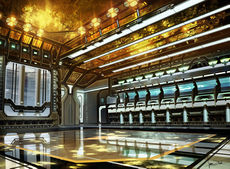 A hall of the Combat Training Center on Arx’s moon
A hall of the Combat Training Center on Arx’s moon
The Center played an indirect but undeniable part in the purges that took place during this period. There was not a lightsaber-wielder in the Brotherhood who did not have a dossier in the classified databases of the ACC. Their styles of combat, aptitudes, foibles, all these were an open book to the Combat Master. Voice Evant Taelyan and his Inquisitorius made extensive use of this intelligence to dispatch the enemies of the Iron Throne, be they Krath, Obelisk or Undesirables.
At the same time, the training facilities of the Combat Center themselves remained aloof of the unrest, at least in the public eye. While they certainly didn’t provide sanctuary to enemies of the Iron Throne, the Center did not tolerate any distractions from their intended purpose, be it seditious activity or Inquisitorius interference. Combat training and practice was still held as the sacrosanct function of the Combat Halls. Marick continued this policy to maintain the broad permeation of the ACC through the Brotherhood, both in terms of combat training and intelligence gathering. Nonetheless, this arguably lenient attitude towards apostates and Undesirables brought a certain amount of tension between the Combat Master and the Grand Master. The friction would eventually come to a head, but for now it smoldered under the surface of the two Masters’ relationship.
Another phenomenon that the combat skirmishes of 33 ABY brought to light were the rising relevance and prestige of non-Force users in the Brotherhood’s martial scene. Not only were they becoming important pieces in the Brotherhood command structure; they were also demonstrating an exceptional aptitude in combat; they could stand toe-to-toe with the Clans’ foremost Force-wielding warriors. The ACC spotted this intriguing trend and adapted accordingly. The Center’s instructors developed combat training programmes for the mercenaries and loyalists, with a strong emphasis on countering the techniques of Force users, and the instructors and operatives began monitoring with greater interest the martial activities of non-Force users within the Clans. To this purpose the Center also enlisted Krin Murphy as Combat Trainer, the first non-Force wielding weapons specialist on the ACC staff.
Pinnacle of Fame
33 to 34 ABY
- "Well I’m a little extra crispy right now, but don’t worry ladies — he didn't hit my face."
- ―Turel Sorenn on Antei
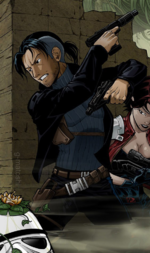 Turel Sorenn, Grand Master’s Champion
Turel Sorenn, Grand Master’s Champion
Combat training and surveillance were not the only occupations of the ACC, especially in the turbulent early years of the reign of Darth Pravus. The brethren of the seven Clans all had personal grudges, disputes of honor or doctrine, past offenses to settle or just simple blood lust. Without some kind of outlet, there was a danger these individual urges could spill into widespread hostilities, Clan feuds and wars. The Grand Master’s Invitational Tournament[5] was precisely one such outlet. Darth Pravus called for this contest as soon as the new Colosseum and its adjacent facilities were completed on Arx’s satellite. The Tournament saw the top two fighters from each of the seven Clans (and two Dark Councillors) perform in non-lethal duels for the entertainment of the Brotherhood at large.
Superficially, the Tournament indulged the age-old recourse of rulers in times of upheaval, part of the “bread and circuses” that kept the populace diverted and contented. But this was also an extraordinary opportunity for the Center’s intelligence gathering mission. The hubris of the Clans had pushed the Brotherhood’s most accomplished warriors to gather in the Colosseum. Each of their duels provided a window into the martial capabilities of their respective Clans, as well as the quality of their pride and resolve. The final duel took place between Turel Sorenn and Timeros, in the ruins of the Dark Hall on Antei. The fight, and Turel’s victory, was broadcast live to all the Clans of the Brotherhood.
Some say it was the nomination of Turel — Jedi and Proconsul of Odan-Urr — as victor and Grand Master’s Champion that pushed Pravus over the edge. Though the conclusion of the Tournament was definitely an unpleasant shock for the supporters of the Iron Throne, it is improbable that it precipitated the coming tragedy on New Tython so directly; disappointing as it was, the defeat of Timeros could not perturb the Grand Master’s patient, ambitious and farsighted plans. In 34 ABY Darth Pravus led the Dark Council and the Iron Legion in an assault of New Tython, the homeworld of the Odan-Urr Jedi. His slaying of the Shard Solari and the razing of the planet surface left the Brotherhood in no doubt as to the position and intent of the Iron Throne.
The event tested the loyalty of every Dark Council affiliate. Marick himself encountered pressure from both his loyalist Center operatives and his superiors. In the end he was forced to expel all his Odanite instructors, and he declared that any known “Resistance” collaborators who appeared in the Center would be detained as traitors. These drastic actions shattered the trusted neutrality of the Combat Halls. The ACC would never again have the universal reach it had enjoyed since its inception, and its monopoly on martial practice was lost as the Resistance factions likely began forming their own independent combat training centers.
The Blood on Your Hands
34 ABY
- "We are all monsters, Zakath. Was it not you who told me that in our first War?"
- ―Voice Marick Tyris on Dantooine
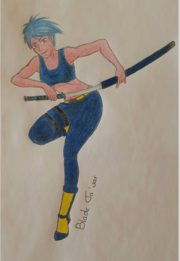 Blade Ta’var, Journeymen’s Champion
Blade Ta’var, Journeymen’s Champion
As the chasms riving the Brotherhood deepened, the ACC’s pervading grip on combat training weakened. The instructors who operated in the rebel Clans had formally severed their ties with Marick, and the Combat Halls on Arx’s moon had become too dangerous for those initiates who were in the sights of the Inquisitorius. It was to counter this impending atrophy that the Combat Master commissioned Alaris Jinn, a seasoned combat trainer, to find the two most promising aspiring warriors amongst the brethren for the purpose of a Journeymen’s duel[6] in the Colosseum on Arx’s moon.
Alaris used the Center’s connections with the Inquisitorius and the Shadow Academy to track the Clans’ up-and-coming Journeymen. Throughout the Twi’lek operative’s investigation two names stood out from the rest: Blade Ta’var of Scholae Palatinae and Aul Celsus of Naga Sadow. The two Knights were invited to fight for the Champion’s title in the Colosseum, under the gaze of the Grand Master, their Clanmates and the rest of the Brotherhood. Blade Ta’var inscribed her victory into the organization’s history as much for the ferocious fight as for her defiance of Darth Pravus, whose scorned demand for her defeated opponent’s death was compounded by the offense of an Undesirable Zeltron becoming Champion.
The Journeymen’s championship proved to the Dark Council that the ACC was still admirably carrying out its intelligence gathering mission, despite the schisms dividing the brethren. The data gathered by Alaris Jinn yielded valuable insights into the competence of Brotherhood Journeymen and the combat training efficacy of the various Clans. At the same time, the Grand Master could no longer ignore the serious insults he had endured from the Center in the past three years. An Odanite Jedi as Grand Master’s Champion, a wilful Undesirable as Journeymen’s Champion and Marick, with his definite links to the fractious Shadow Clan, as Combat Master. Loyalist elements of both the Dark Council and the Center staff were beginning to voice their doubts and discontent.
By electing Marick to be the new Voice, Pravus thought to force the Hapan’s hand, to test what bridges he was ready to burn for the sake of the Brotherhood. On Dantooine Marick murdered loyal Arconan and old acquaintance Zakath Agrona, thus removing the Dark Council’s doubts regarding his commitment to the Iron Throne. At the same time the Grand Master appointed Atra Ventus as the new Combat Master. This Umbaran was an experienced Inquisitor and agent of the Combat Center, whose dedication to the order of the Brotherhood was indisputable. Pravus also placed the new Combat Master in Clan Arcona. In one stroke the Dark Lord had validated the loyalty of a master assassin, secured the stability of the ACC and ensured that any links between the Center and the mutinous Arcona worked solely to the Iron Throne’s advantage.
Long to Reign
34 ABY
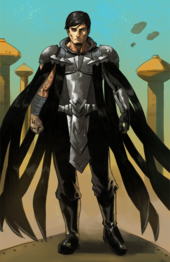 CM Atra Ventus
CM Atra Ventus
The appointment of Atra as Combat Master may have stabilized the structure of the Dark Council, but the Center was still having to contend with the issue of increasing separation between it and the Clans. As a consummate Inquisitorius operative, Atra had no trouble solidifying and expanding the ACC’s network of informants, double agents and surveillance stations (for these are what the trainers, instructors and dojos still loyal to the Center had largely become). However, Atra knew the flame of the Combat Center was fuelled by more than espionage. A being’s true martial strength and commitment are only revealed in the bloodlet of open confrontation, and the induced isolation of the Clans now made that too sporadic an occurrence. The Combat Master needed a crucible wherein to test the brethren in open combat. He found this opportunity when he visited the Godless Matron in the Shroud.
The base of operations of the Brotherhood’s Herald at the time, Morgan B. Sorenn, was a smuggler’s haven and a pirate cove. Though Morgan ultimately worked for the Grand Master, the Matron’s shanty towns were a law unto themselves, and as such they attracted both Resistance and Inquisitorius types for their secret meetings and shady dealings. Add to this the Shroud Syndicate gangs looking to test the dominance of their Captain, and Morgan had a tinderbox ready to be lit. The deal she struck with Atra meant that, once she threw the match, she could unleash the restive gangs on the Brotherhood and Resistance intruders. On Atra’s part, the Center was given free run of the monitoring systems in the Ball, with which they tracked the myriad confrontations that broke out across the ship[7].
The brethren trapped in the ship had no choice but to fight, and in so doing they disclosed their strengths and weaknesses to the ACC’s data gathering operatives. One Taldryanite, Andrelious Mimosa-Inahj, stood out above the rest in fighting prowess, though Atra was not solely interested in martial ability. He took special note of the factors that pushed Andrelious and the other warriors to fight on the Matron. Knowledge of their hopes and fears, as revealed in the heat of battle, was a weapon more deadly than a blaster nozzle at one’s temple in the hands of the Grand Master.
References